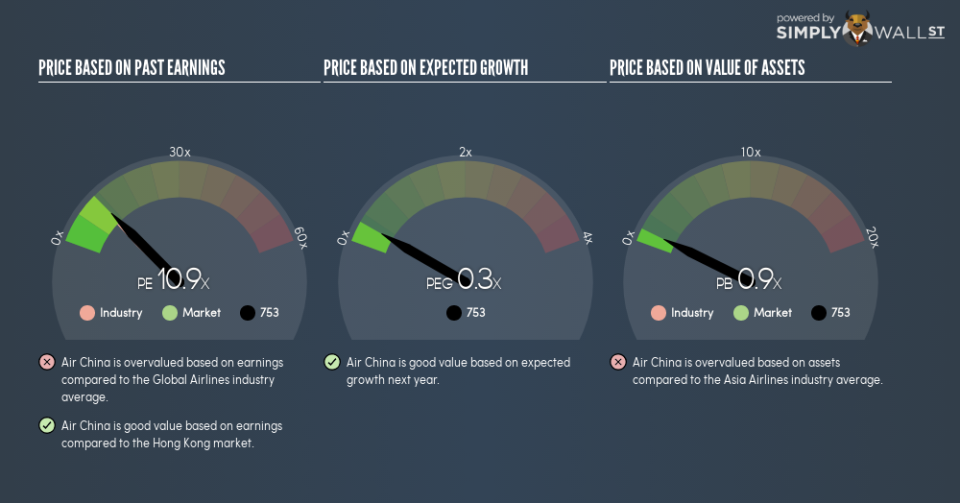What Does Air China Limited’s (HKG:753) PE Ratio Tell You?

This analysis is intended to introduce important early concepts to people who are starting to invest and want to begin learning about how to value company based on its current earnings and what are the drawbacks of this method.
Air China Limited (HKG:753) is trading with a trailing P/E of 10.9, which is higher than the industry average of 9.8. Though this might seem to be a negative, you might change your mind after I explain the assumptions behind the P/E ratio. Today, I will deconstruct the P/E ratio and highlight what you need to be careful of when using the P/E ratio.
Check out our latest analysis for Air China
Breaking down the P/E ratio
P/E is a popular ratio used for relative valuation. By comparing a stock’s price per share to its earnings per share, we are able to see how much investors are paying for each dollar of the company’s earnings.
P/E Calculation for 753
Price-Earnings Ratio = Price per share ÷ Earnings per share
753 Price-Earnings Ratio = CN¥5.83 ÷ CN¥0.537 = 10.9x
The P/E ratio isn’t a metric you view in isolation and only becomes useful when you compare it against other similar companies. Our goal is to compare the stock’s P/E ratio to the average of companies that have similar attributes to 753, such as company lifetime and products sold. One way of gathering a peer group is to use firms in the same industry, which is what I’ll do. Since 753’s P/E of 10.9 is higher than its industry peers (9.8), it means that investors are paying more for each dollar of 753’s earnings. This multiple is a median of profitable companies of stocks internationally, operating in the Airlines industry. I’ve decided to use a global peer group as there’s not enough companies in HK that are considered as appropriate peers, and I wanted to get a broader perspective on the regional multiple. Some peers include Cathay Pacific Airways, and . You could think of it like this: the market is pricing 753 as if it is a stronger company than the average of its industry group.
Assumptions to watch out for
However, you should be aware that this analysis makes certain assumptions. Firstly, that our peer group contains companies that are similar to 753. If this isn’t the case, the difference in P/E could be due to other factors. For example, Air China Limited could be growing more quickly than the companies we’re comparing it with. In that case it would deserve a higher P/E ratio. Of course, it is possible that the stocks we are comparing with 753 are not fairly valued. So while we can reasonably surmise that it is optimistically valued relative to a peer group, it might be fairly valued, if the peer group is undervalued.
What this means for you:
You may have already conducted fundamental analysis on the stock as a shareholder, so its current overvaluation could signal a potential selling opportunity to reduce your exposure to 753. Now that you understand the ins and outs of the PE metric, you should know to bear in mind its limitations before you make an investment decision. Remember that basing your investment decision off one metric alone is certainly not sufficient. There are many things I have not taken into account in this article and the PE ratio is very one-dimensional. If you have not done so already, I urge you to complete your research by taking a look at the following:
Future Outlook: What are well-informed industry analysts predicting for 753’s future growth? Take a look at our free research report of analyst consensus for 753’s outlook.
Past Track Record: Has 753 been consistently performing well irrespective of the ups and downs in the market? Go into more detail in the past performance analysis and take a look at the free visual representations of 753’s historicals for more clarity.
Other High-Performing Stocks: Are there other stocks that provide better prospects with proven track records? Explore our free list of these great stocks here.
To help readers see past the short term volatility of the financial market, we aim to bring you a long-term focused research analysis purely driven by fundamental data. Note that our analysis does not factor in the latest price-sensitive company announcements.
The author is an independent contributor and at the time of publication had no position in the stocks mentioned. For errors that warrant correction please contact the editor at editorial-team@simplywallst.com.

